Ardennes operation
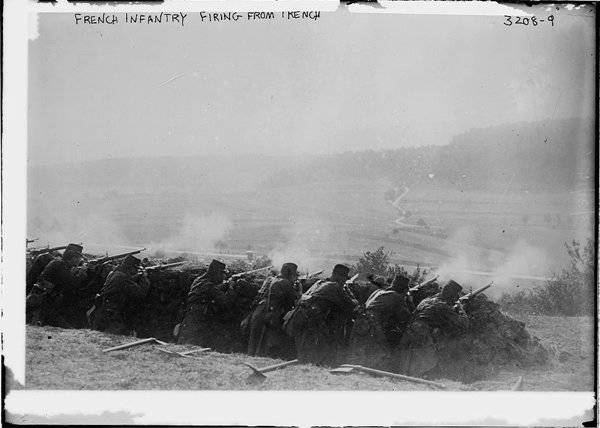
Despite the failure of the 1 and 2 French armies in Alsace and Lorraine, the French command did not cancel the offensive in the central sector, in the Ardennes. It was assigned to 21 August 1914, although the German assault group had already prepared for the throw. The Germans knew about the French offensive, and the French were convinced that there were no large forces against them, that they had gone to Belgium. The French commander-in-chief Joffre even forbade conducting reconnaissance in order not to lose surprise.
The location of the troops. Forces of the parties
By 20 August, the 1-I German army of Kluka, highlighting the 3-th reserve corps to pursue the Belgian troops in the Antwerp direction and leaving the 4-th reserve corps at Tyrlemon, went to the Brussels region. 2-I Bülow's German army, highlighting the Guards reserve corps to take the Belgian fortress of Namur, was on the line Ohen-Gemblu. The 3-th German army of Hausen, having sent the 11-corps to Namur, reached the line Aversin, Siernon, pushing the 1-th cavalry corps forward. 4-I German army of Prince Albrecht of Württemberg advanced to the line Bastogne - Atter. The 5 Army of the German Crown Prince Wilhelm entered the Etal - Longwy - Arsweiler line.
The 3-I French army of Rufé was opposed by the 5 of the German army and was located in the region of Verdun, Eten and Zhamets. The 4-th French army of Langles-de-Kari was opposed by the 4-th of the German army and was stationed in the Monmedi area, Charleville. The 5-I French army of Lanrezac was opposed by the 3-th and 2-th to the German armies, located between Sambre and the Meuse. Forward was nominated cavalry corps Sorde. The French Expeditionary Force Corps was located in Maubeuge, Mons. Against the British troops were the corps 1 of the German army.

British cavalry in Belgium
The aspect ratio on this sector of the Western Front was approximately equal. The French armies (3, 4 and 5) had 630 battalions, 286 squadrons, 2 658 guns. The French troops were opposed by the 644 battalion, 385 squadrons, 3 484 guns of the German armies (2-I, 3-I, 4-I and 5-I). True, the English corps was weaker than the 1 of the German army. The British had 48 battalions, 39 squadrons, 334 guns, and in the 1 German army there were 120 battalions, 104 squadrons, 748 guns. In addition, German troops had the advantage in artillery and in relation to the allies (the French and the British) occupied a covering position.
Source of maps: Kolenkovsky A. Maneuverable period of the first world imperialist war 1914.
Plans
The 3-I French army was to advance in the general direction on Arlon, the 4-I army on Nevshato. The 5 Army, with the support of British troops, also had to attack the enemy’s northern grouping, relying on the right flank of the Belgian fortress of Namur.
The French command had erroneous information about the enemy. It was believed that 13 corps and 7 cavalry divisions were located in total against the French army in Belgium and Luxembourg: 7 German corps and 4 cavalry divisions in the northern grouping on the Meuse, north of Namur; 3 Corps and 1 Cavalry Division in Belgian Luxembourg; the rest of the troops in reserve. In reality, the 26 of the German corps was located here with reserve corps, not counting the troops in Metz.
Thus, the French doubled down on the enemy forces. On the movement of the German troops, the French had almost no data. In addition, Joffre did not pay attention to the strong 5 of the German army, which could threaten the flank and rear of the 3 of the French army during its movement. And the 5-I French army and British troops had to confront the three German armies.
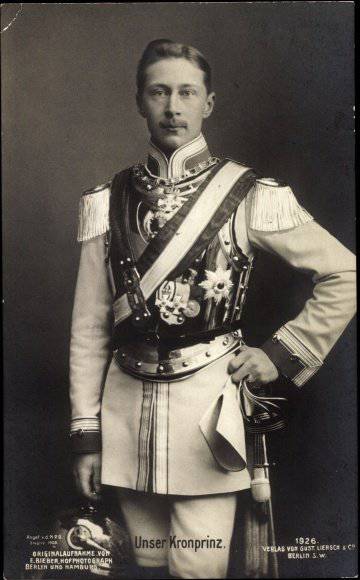
Commander of the German Army 5 th Crown Prince Wilhelm (Friedrich Wilhelm Victor August Ernst of Prussia)
Ardennes operation
The defeat of the 3 Army. In the Ardennes, hostilities took place between the 3 and 4 by the French armies and the 4 and 5 by the German armies. By 20 August 3-I French army was located on the line Eten - Zhamets. In the area of Verdun there was an army group of reserve Duran divisions (the so-called Lorraine army). 21 August The 3 Army received the task of reaching the Pierpon line, Virton.
Meanwhile, the German troops, which were concentrated in the Metz area, Diddenhofen, by the evening of August 20 reached the Etal line, Arsweiler. The Germans were just one transition from the unsuspecting French. French columns literally ran into German positions. The first rows dared artillery and machine-gun fire. It was convenient for the Germans to take aim, the French did not think about changing their uniforms, red trousers and blue uniforms stood out well even in the morning fog. The French did not embarrass the first losses, the thought that it was necessary to scout the situation and go on the defensive was not there, because they were taught to act like Napoleon, swiftly and decisively, in an attacking style. Yes, and how to go on the defensive, if you did not learn to dig in, and there was no trench tool? As a result, as soon as fresh parts arrived, they were thrown into suicide attacks. The officers were bravely the first to go, they stood out well with white gloves and plumes on the red caps, so they were knocked out like in a dash.
The fierce oncoming battle lasted two days. Losses were big on both sides. The Germans also acted in dense columns, so when they were covered by French artillery, they suffered huge losses. Eyewitnesses described the ravine under Virton, where hundreds of corpses literally stood, since they could not fall. However, the French were worse, they ran into the enemy’s prepared defenses.
On the left flank of the French army, in the area of Virton and Et, the 4 of the French corps ran into the position of the 4 of the German corps. After a fierce battle, the French were driven back to the Krün River. In battle, the Germans used heavy artillery. True, the artillery was located in open positions, and therefore suffered serious losses.
The situation in the center for the 5 French Corps, advancing at Blade and Fort Longwy, was even more unfortunate. The Germans were already preparing to storm the fort, pulling up heavy artillery. As a result, the 13 th German corps knocked over the French with heavy losses. The French could have suffered a more serious defeat if the Germans began the persecution right away. However, due to the ambiguity of the situation, the German command was in no hurry to pursue, so the French troops were able to clean up. The 6-th French Corps took over the battle in Lex, Unie. Under pressure from the 6-th Reserve German Corps, which the 5-th Reserve German Corps approached, the French were pushed aside to Arancy and Pierpon.
The 16 of the German corps advanced into the girth of the right wing of the 3 of the French army. The French 7 Cavalry Division, which was on its way, retreated from Auden-les-Romain to Rashikur. French reserve divisions from the Verdun area did not have time to close the dangerous direction, so one 40-French division was in the way of the German troops. During the 22 of August, she withstood the onslaught of the overwhelming forces of the enemy, and then withdrew to Nuionpon.
Thus, the offensive of the French corps ran into the oncoming movement of the Germans, who knew better about the movement of the enemy forces, and choked with blood. The situation on the right flank was so dangerous that the French command doubted that the battle could be continued, although this wing had a powerful reserve of 7 divisions, the so-called. Lorraine Army (Durand Army Group). The main reason for the failure of the French army was the poor organization of intelligence (in this respect, the French were no better than the Russian command). In addition, the French command dispersed forces, the 3-I French army acted in divergent directions, which led to a lack of forces in the main (Arlon) direction.
The German troops, despite the success in the oncoming battle, also acted not in the best way, not using the enemy's retreat for his decisive defeat. The Germans, like the French, could not make full use of their cavalry, although on the flanks of the 5 of the German army there was a cavalry division. In addition, the command of the 5 Army decided not to continue the offensive, while maintaining contact with the serf district of Diddenhofen, Metz. Only in the morning of August 23, the German High Command ordered the 5 Army to continue the offensive in a westerly direction and reject the enemy troops in the area north of Verdun.
Despite the failure of the 3 of the French army, the French commander Joffre did not believe what had happened, demanded to stop the retreat and resume the attack "in the common interests of the operation." The French underestimated the enemy forces. 3-I French army received an order again to go on the offensive. As a result, the oncoming battle continued.
However, on August 23, the situation at the front was relatively calm and only interrupted by an artillery exchange of fire. French troops put themselves in order and did not rush to attack. Germanic units received an order of attack late and rested, they were very tired in the previous days. Only 24 August battle resumed.
True, on this day among the French generals a dispute broke out about what to do next. Joffre, having received data on the retreat of the 4 and 5 of the French armies and the British group of troops, ordered the 3 army to withdraw to the line Monmedi - Damvilliers - Azan. However, the commander of the 3 Army Ryufe, on the contrary, wanted to abandon the Lorraine army against the left flank of the German army. The motive for this decision was the interception of the German car, where there was an order revealing the coverage plan for the right fang of the French army. The commander of the Lorraine army Monouri refused to carry out the order of Ryufe, referring to the order of Commander-in-Chief Joffre. When they turned to Joffrey for final instructions, Joffre took off his responsibility and offered to resolve the issue on the spot. The whole day passed in disputes, the French never launched an offensive. As a result, the French decided to support the offensive of the right-flank 6 corps with three divisions from the Lorraine army.
Meanwhile, the Germans continued the offensive. French troops were pushed over the river Autun. In the morning of August 25, the German troops continued their offensive, crossed the Othen River, occupied Marville, Dombra. The French retreated to the Maass heights in the area of Den, Damvilliers and Azan. However, the troops advancing on Nuionpon had to stop and take measures to strengthen the left flank.
On the left flank, the situation for the German army was not the best. Here a group of reserve French divisions launched an offensive. In the morning the Germans attacked Gusenvenville, Eten, Hamel and Domremy on the front, but 72-I, 56-I and 75-I went to the flank. The French occupied Ethen and Gusenville, forced the river Orne and began to push the Germans to Muavil. As a result, the German troops in disarray retreated to the line Lyadr - Brie. The French cavalry attempted to reach the rear of the Germans, but was stopped by troops from the German fortress of Metz.
The success of the reserve divisions on the right flank was not consistent with the general defeat of the 3 of the French army, so the Duran group was ordered to stop. In the evening of August 25, Duran's troops were ordered to stop the offensive. However, the success of the Duran group made 5 of the German army stop, pull some of the forces to the right flank. This allowed the French to put themselves in order and gain a foothold on the Maas Heights.
Defeat of the 4 Army on the Semois River
By the evening of August 20, the 4 of the French army of Langles-de-Cary was located on the river Meuse between Montmedy and Charleville. On August 21, the right-flank 2 and the colonial corps went forward to Mei and Jamuan. In the center of the 12, 17 and 11 of the corps were advanced units to Floranville, the Semois River, to Bertri and Ofan. The left-handed 9 body came up to Monceau. In the 4 Army, as in the neighboring 3 Army, the French had little information about the enemy. It was believed that the 4 Army should strike the flank of the German troops advancing in Belgium, that there were only small detachments in front of the army that did not pose a threat.
In addition, the situation was complicated by the nature of the terrain. The forest covered two thirds of the upcoming theater of operations. There were few roads. The terrain was carved by ravines. All this made the action of large compounds difficult. Because of the rough terrain, it was difficult to organize the interaction of infantry and artillery. The troops during the movement greatly stretched, and when the battle began, they were brought into battle in parts.
By the evening of August 20, the units of the 4 of the German army of the Duke of Württemberg reached the line Amberl, Legliz. The command of the army carried out the order from August 17 - to cover the left flank of the 5 army. Airborne intelligence and clashes with the French cavalry gave the Germans information that the large enemy forces were located between the rivers Meuse and Semois. The command of the army decided to attack, keeping in touch with the neighboring 3 and 5 of the German armies. 21 August German troops took to the line Saint-Hubert, Libremon, Legliz.
22 August French troops continued to move to the northeast, unaware of the impending threat from the flank. The movement of the French corps was not provided not only with intelligence, but also with escort, which led to defeat and high losses. Parts of the left-flank 9 corps of the enemy were not met. The troops of the 11 and 17 of the French corps met in the area of Oshan, Mecen parts of the 18 of the German corps. The Germans were driven back to Liben. At that time, parts of the German 8 of the reserve corps approached from the north, two German corps stopped and forced the French to retreat to the Semois River in the Bouillon area. The Germans did not pursue the mixed parts of the enemy.
The remaining French troops also did not succeed, faced with large masses of German troops. The 12 th French Corps fought hard all day with units of the 18 German Reserv Corps in the Stremon and Saint-Médard region. The colonial corps attacked the German positions in the area of Zhamuan, Rosignol, Syuxi. Here, parts of the 18 of the German reserve and 6 of the army corps managed to partially dig in and prepare machine-gun positions. The colonial units bravely rushed to the attacks and suffered heavy losses from machine-gun fire. After initial successes, the colonial corps was driven back to the Semois River. The 2 of the French corps near Virton ran into the fortified positions of the enemy and suffered heavy losses from artillery fire.
The unexpected defeat caused by extreme negligence and disregard for elementary precautions demoralized French troops. The French command, having no information about the enemy, discouraged by failure, hesitated. The 11 and 17 corps were upset and could not attack. 23 August continued the offensive only left-flank 9-th corps. However, the French clashed with parts of the 8 of the German corps. First, the French cavalry rolled back, then the 9 Corps retired to Montermo and Mambre. In the center and on the right flank, the situation for the French was also unfortunate. The French corps moved to the line Monmedi - Remilly.
Despite the demands of the command to resume the offensive, the French troops retreated in disarray, sometimes even without orders and minimal resistance, exposing the flanks of their neighbors and forcing them to retreat. The decisive offensive of the German forces could have led to the complete defeat of the 4 army, but the Germans did not hurry, moved cautiously, keeping in touch with the 3 and 5 armies.
24 August was not serious fights. The Germans went to the river Semois, where the French left not destroyed ferry. On August 25, French troops retreated across the Meuse River, restraining weak pressure from the rearguard enemy. 26 August, the French army entrenched on the Meuse river at the Mezieres-Remillia-Sasse line.
Results
Thus, due to the mistakes of the command of the 4, the French army suffered serious losses in manpower and weapons, returning to its original position. It was guilty as the supreme command, underestimating the enemy, did not guess the direction of the main attack, and the army command, which neglected the elementary measures of reconnaissance, escort and threw the corps into battle in parts. The first defeats demoralized the French troops, and then they no longer offered serious resistance, rolling back to the Meuse.
The French army could have avoided a more serious defeat only because of lethargy and passivity of the onset of the German 4 th army, before which the high command did not set decisive goals. For the German army, the situation was extremely advantageous. However, the Germans also poorly organized reconnaissance and missed the opportunity to inflict a powerful flank attack on the French army. Therefore, the French troops were able to freely go beyond the Meuse and organize the defense.
As a result, the Ardennes operation ended with the victory of the German troops and the defeat of the 3 and 4 of the French armies. The French, instead of leading a decisive offensive, which was supposed to lead to victory in the 1914 campaign of the year, went on the defensive. The plan of the French command on the flank attack on the German corps, advancing in Belgium, collapsed. The French had to abandon the idea of an offensive through the Belgian Luxembourg and go to a strategic defense. In turn, the German 5-I and 4-I armies, instead of only holding back the attack of the French troops, themselves launched an offensive.
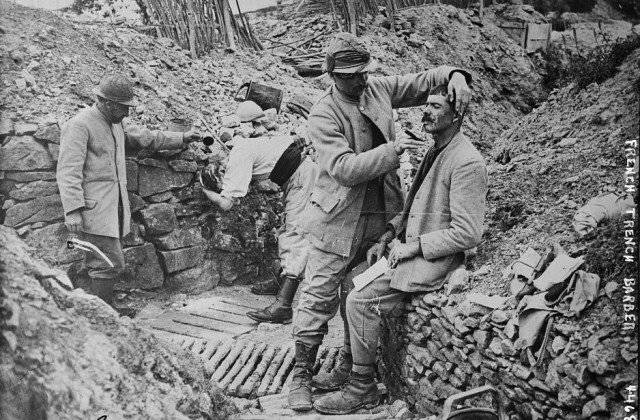
French trenches. 1914 year
Articles from the Western Front series:
Western front: French self-confidence, Germanic blitzkrieg dreams and the rout of Belgium
The assault of Liege and the fall of Antwerp
Battle of Mühlhausen. Vosges and Lorraine operations
To be continued ...
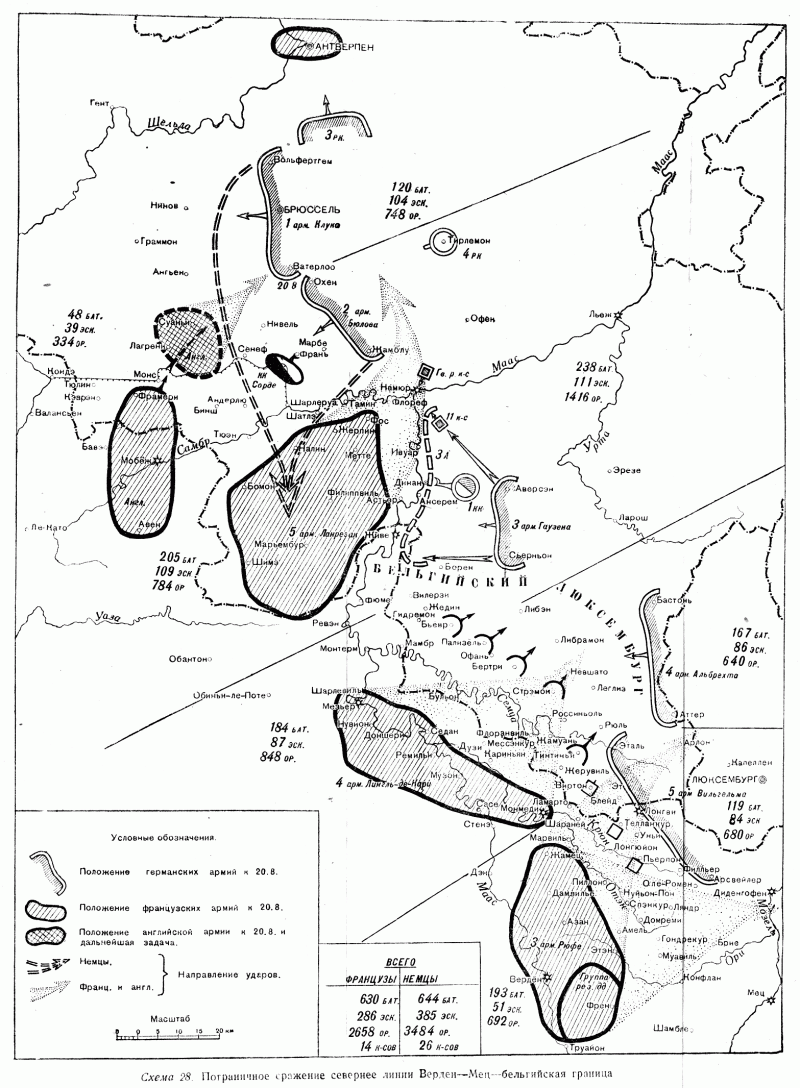
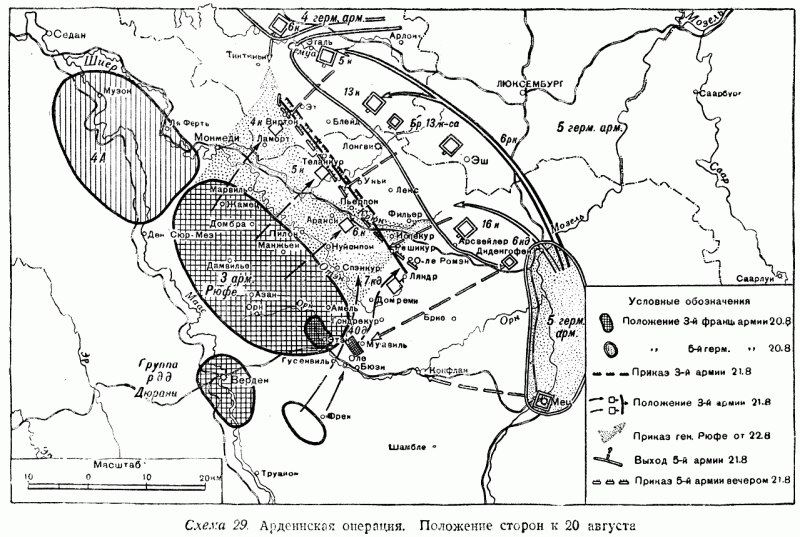
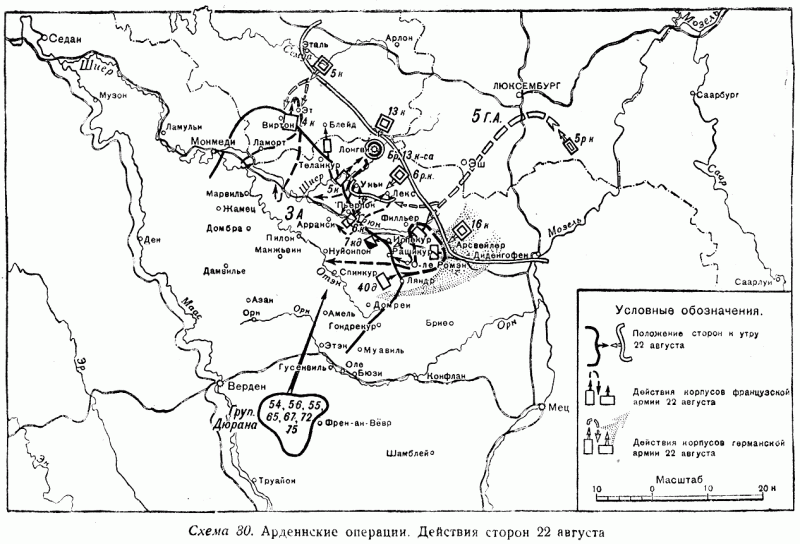
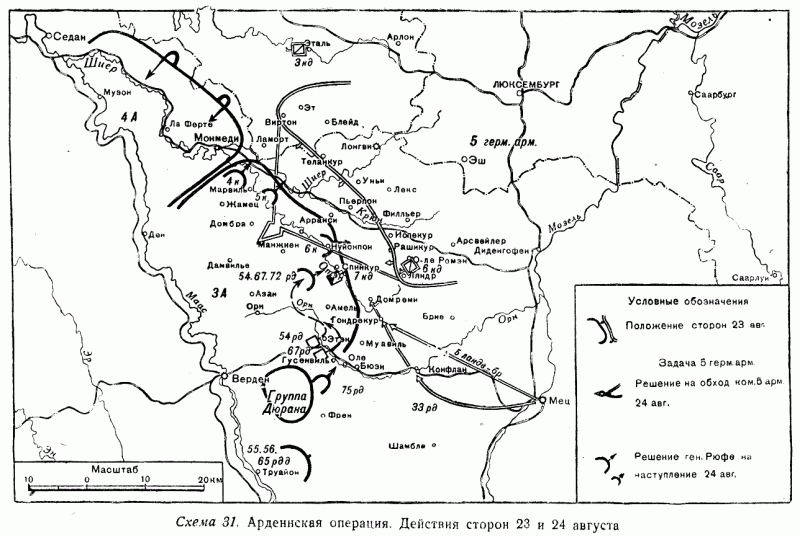
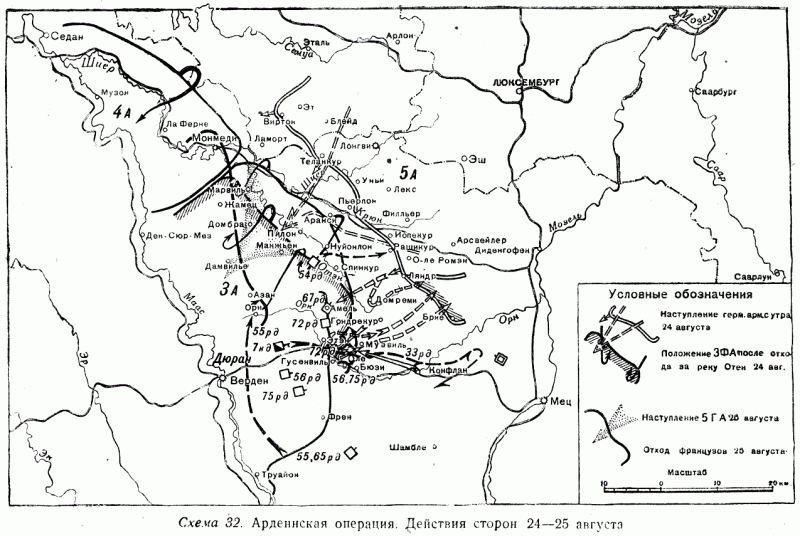
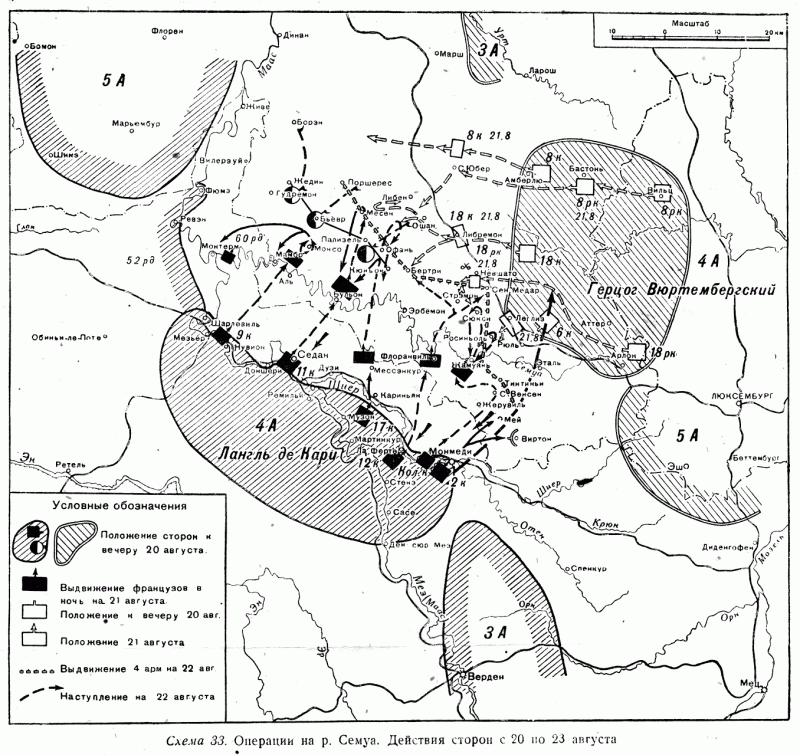
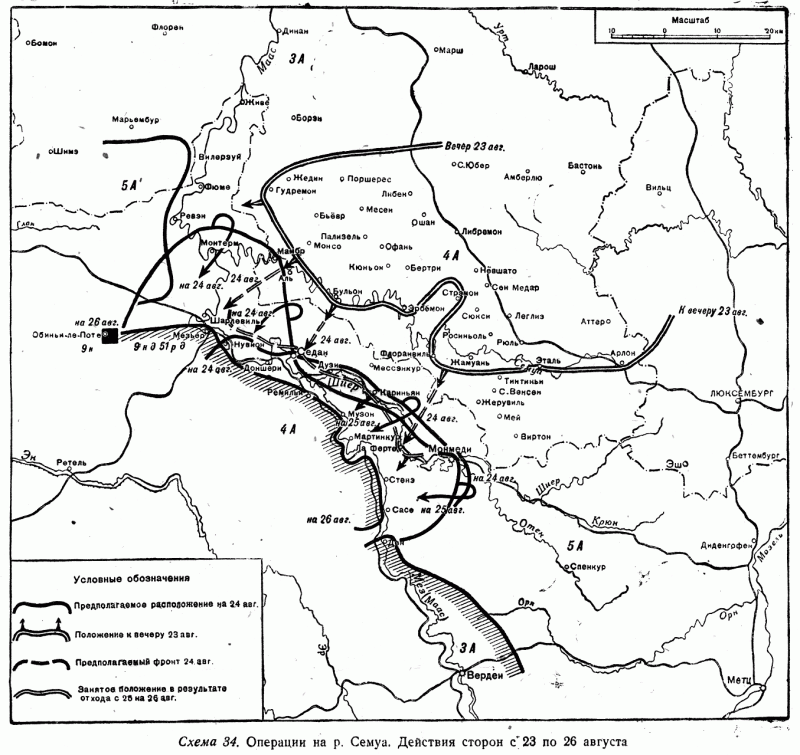
Information